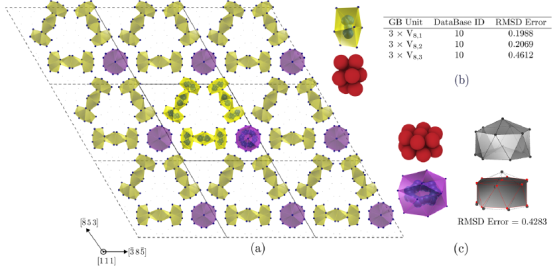 A three-dimensional polyhedral unit model for grain boundary structure in fcc metals(fcc金属晶界结构的三维多面体单元模型)
A three-dimensional polyhedral unit model for grain boundary structure in fcc metals(fcc金属晶界结构的三维多面体单元模型)
Arash Dehghan Banadaki & Srikanth Patala
npj Computational Materials 3, Article number: 13 (2017)
doi:10.1038/s41524-017-0016-0
Published online:27 March 2017
Abstract| Full Text | PDF OPEN
摘要:发展真正的bottom-up模型计算多晶材料性能的最大挑战之一就是界面缺乏准确的结构-性能定量关系。作为分析这种关系的第一步,我们提出了一个“多面体单元”(polyhedral unit)模型,可以沿晶界的原子堆积几何结构特征进行分类。尽管无序系统中的原子结构一直是数十年来受到关注的问题,但由于其结构范围变化复杂,结构又可能具有基本宏观结晶学特征,所以晶界的几何结构分析特别具有挑战性。本研究提出了一种可以将原子间结构划分为三维多面体连接阵列的算法,从而提出了一种用于晶界分析的三维多面体单元模型。还提供了“点模式匹配”(point-pattern matching)算法,用于量化所观察的晶界多面体扭转。多面体单元模型能够准确描述高-Σ、耦合特征界面结构,因此它提供了一种几何结构方法,用来比较涵盖五参数晶体相空间的晶界结构。由于所获得的多面体单元限定了结构中的空隙,因而这样的分析提供了关于晶界内分离位点的有效信息。期望这种计算技术成为分析晶界结构的有力手段。本研究所提出的多面体单元模型算法适用于广泛材料体系的基本晶格结构分析。
Abstract: One of the biggest challenges in developing truly bottom-up models for the performance of polycrystalline materials is the lack of robust quantitative structure–property relationships for interfaces. As a first step in analyzing such relationships, we present a polyhedral unit model to classify the geometrical nature of atomic packing along grain boundaries. While the atomic structure in disordered systems has been a topic of interest for many decades, geometrical analyses of grain boundaries has proven to be particularly challenging because of the wide range of structures that are possible depending on the underlying macroscopic crystallographic character. In this article, we propose an algorithm that can partition the atomic structure into a connected array of three-dimensional polyhedra, and thus, present a three-dimensional polyhedral unit model for grain boundaries. A point-pattern matching algorithm is also provided for quantifying the distortions of the observed grain boundary polyhedral units. The polyhedral unit model is robust enough to capture the structure of high-Σ, mixed character interfaces and, hence, provides a geometric tool for comparing grain boundary structures across the five-parameter crystallographic phase-space. Since the obtained polyhedral units circumscribe the voids present in the structure, such a description provides valuable information concerning segregation sites within the grain boundary. We anticipate that this technique will serve as a powerful tool in the analysis of grain boundary structure. The polyhedral unit model is also applicable to a wide array of material systems as the proposed algorithm is not limited by the underlying lattice structure.
Editorial Summary
Polyhedral structures: Building blocks for metallic interfaces(多面体结构:金属界面的构件)
美国研究人员设计了一个模型来帮助了解诸如铝和铜等金属中晶体是如何堆积形成的机制。大多数金属形成多晶微结构,即它们由许多不同尺寸和取向的小晶体组成。在不同取向的晶界处,缺乏有序结构,难以对其性质进行建模。针对这些问题,北卡罗来纳州立大学的Arash Banadaki和Srikanth Patala首先对这些界面结构与微观单元结构的关系作出了定量处理,开发一个三维模型,依据微结构中原子沿着无序区域堆积模式的几何结构进行分类。该模型虽然只在面心立方晶体上进行了测试,但也适用于其他有不同晶格结构体系。本方法是通过自下而上设计出所需性能的结构材料的第一步,也是关键一步。
US researchers have designed a model to aid understanding of how crystals pack in metals such as aluminum and copper. Most metals form as polycrystalline microstructures, i.e., they are composed of small crystals of varying size and orientation. The lack of structural order, along the interfaces where crystals of different orientations meet, m it difficult to model their properties. Arash Banadaki and Srikanth Patala at North Carolina State University have taken the first step towards quantifying these relationships, by developing a three-dimensional model that classifies the geometrical nature of how atoms pack along these disordered regions in the microstructure. The model was tested on face-centered cubic crystals, but is also applicable to systems with different lattice structures. This is a key first step in the bottom-up design of structural materials with desired properties.


 沪公网安备 31010502006565号
沪公网安备 31010502006565号